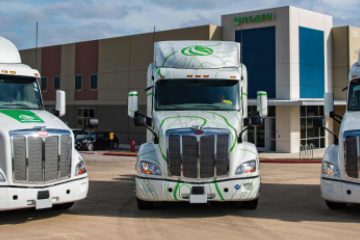Steel interests salute feds’ low-carbon construction material pursuits
Sources: American Institute of Steel Construction, Chicago; CP staff
The American Institute of Steel Construction (AISC) reports that members are ready to meet expanded White House Federal Buy Clean Task Force objectives announced during a September 15 gathering at the Cleveland-Cliffs Toledo Direct Reduction plant in Ohio. Transportation Secretary Pete Buttigieg, U.S. General Services Administration Administrator Robin Carnahan, and Deputy National Climate Advisor Ali Zaidi noted that federal agencies will prioritize the purchase of key low-carbon construction materials: steel, along with concrete, asphalt and flat glass.
DOT, GSA and other agencies will advance a new Federal Buy Clean Initiative to jumpstart partnerships encouraging alignment of White House and state Buy Clean program goals and execution. DOT is also announcing an agency-wide Buy Clean policy and Embodied Carbon Work Group with an eye to better a) data and reporting; b) procurement and purchasing methods; and, c) education and research to ensure the use of sustainable materials across its construction contracts. With upward of $350 million in funding or grants, moreover, White House officials seek to expand the reliability, transparency and verification of environmental product declarations—including greenhouse gas emissions reporting—for actual supply chain production of key construction materials.
“We applaud efforts to lower emissions in the construction sector, and look forward to continued collaboration with the Federal Buy Clean Task Force,” says AISC Director of Government Relations and Sustainability Max Puchtel, SE, PE. “As America already leads the world in producing low-embodied-carbon fabricated structural steel and transparently disclosing environmental impacts—all while responsibly complying with environmental and labor regulations—[our] industry is uniquely positioned to continue its leadership role and deliver on Buy Clean and Buy America priorities.”
“A clean, green future is critical and it’s already building in steel today. The hundreds of thousands of Americans in the structural steel industry have been working toward carbon neutrality for decades,” adds AISC President Charles Carter, SE, PE, PhD. “The smokestacks are long gone—in fact, the vast majority of the few emissions that remain from structural steel beam production now come from the power grid.”
That emissions factor stems from domestic mills’ use of electricity to turn scrap metal into new structural steel beams. The average steel beam or column forged in a domestic electric arc furnace mill contains 93 percent recycled material. That process emits 75 percent less carbon dioxide than traditional methods and is responsible for every single American structural steel beam forged today.
Across the industry, AISC observes, steel mills are building their own sustainable power fields and installing carbon scrubbing equipment. Member fabricators are likewise taking their own steps to reduce energy consumption and, in some instances, using the vast roof areas over shops to harbor solar panels.
Related articles
Feds earmark $100M to decarbonize cement, companion industries
Agency eclipses typical government pace with embodied carbon action
